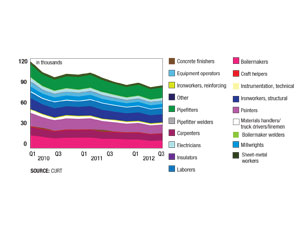Trying to make the impossible possible is the kind of challenge that Daniel Groves likes. His latest success: Directing development and launching a national labor supply/demand forecasting model for the nonprofit Construction Workforce Development Center. The model was commissioned by the Construction Users Roundtable, where Groves is now director of operations.
“It is the first tool deployed industry-wide that will allow the labor component of a project to be planned and managed. It will improve efficiency and effectiveness in labor utilization as well as overall project execution,” says James Porter, retired vice president of engineering at DuPont. “The bottom line is we’ll all be getting more construction for our money.”
Owners, contractors, labor organizations and local user council members who enter data in the Web-based data-collection and forecasting tool are now able to run forecasts at no charge. “We still have a limited amount of data in the model, but it is growing every day,” Groves says. In the model’s first 10 months of operation, 219 users have entered data on projects that total more than $30 billion. The model is available at www.cwdcforecasting.com.
Groves says the work was funded by sponsors who see the need for good forecasting data. In addition to CURT, sponsors include BE&K, Chevron, DTE Energy, the Tennessee Valley Authority, Southern Co., Bechtel and the Gulf Coast Workforce Development Initiative.

Being tenacious has been a driving characteristic of Groves’ career. In 1998, he became chief of staff to U.S. Rep. Ernie Fletcher (R-Ky.) after managing Fletcher’s successful campaign for office. In 2003, Groves managed Fletcher’s campaign for Kentucky governor, winning the seat for the Republican Party for the first time in 40 years. Groves served as chief of staff and senior adviser to the governor.
Regional groups such as the Southeast Manpower Tripartite Alliance had achieved success with labor demand projections. But these efforts did not account for the movement of crafts from region to region. When CURT boosted this to a nationwide effort, Executive Vice President Greg Sizemore tapped Groves. It took political savvy, plus “the passion to bring all the stakeholders to the table and align them,” says Sizemore.
Once a small contractor, Groves was happy to return to construction. Most of his work life has been spent “wearing a suit and tie,” he says, but some of his “most rewarding days were swinging a hammer. I really enjoy construction.”






Post a comment to this article
Report Abusive Comment